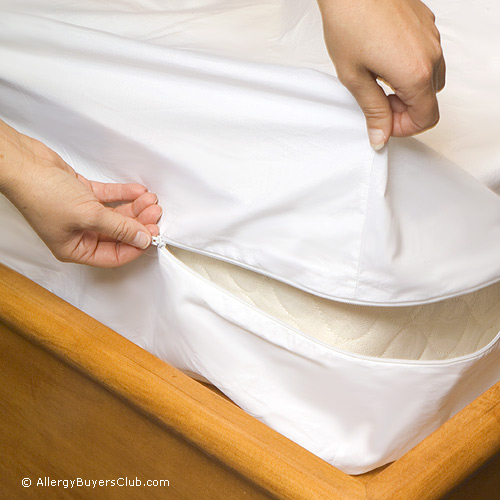Dust Mite Allergies and Mold in Mattress Q&A
Question:
From: Aimee R
Hello… I have some questions in regards to allergies I am experiencing. I believe that my mattress is molded… is this possible. A couple of months I was experiencing a severe allergic reaction, we narrowed it down to the bedroom and an allergist told me I have a severe allergy to dust mites. I got all of the dust mite bedding, etc. My allergies are somewhat at bay, but they are still bothersome (red eyes, puffy red skin around my eyes and wheezing when I get into the bed). Can the dust mites be affecting me through the dust mite bedding? Can the mattress be infected with a mold (we lived in a noninsulated house for three years, come to find out the outside of the house was completely covered in mold?) Is there a way for me to clean the mattress or should I just purchase a new one?
Nobody seems to have any answers for me, hopefully you and your team can offer me some insight and advice.
Thank you for your time.
Aimee R.
Answer:
Hi Aimee,
There are other things you can do to control dust mites but you will need to do these things on a regular basis. First, you should wash your bedding in hot water because temperatures of 135 degrees and higher will kill the dust mites. Second, if you vacuum your rugs, bedding, and upholstery where dust mites live you will remove them for about two weeks. Third, if you vapor steam clean your bedding, rugs, and upholstery along with the vacuuming, the dust mites will be controlled for up to eight weeks.
The use of dust mite encasings is very effective but you are not eliminating the dust mites but keeping them between you and your bedding.
The best way to control the dust mites in your home is to maintain the relative humidity at 50% or below. The reason is that dust mites like a humid environment. When the air becomes dry the dust mite becomes less active and they will not reproduce. In addition, the larva and eggs will not hatch unless the humidity is 60% or above. Therefore, the population of dust mites will be greatly affected by what the humidity level is in your home. Eventually, the adult dust mites will die and the elimination of their reproducing will bring about their elimination.
Regarding the mold issue in your bedding, if this is truly the case, there is little you could do. You would need to replace the bedding. If you do think you have a mold problem in your home you would need to first consider the source of it (where it came from) and eliminate the potential for it to reoccur. Next, you would want to eradicate the mold you have by cleaning it up. The area needs to be isolated so it cannot spread to other areas of the house. It would probably be best to perform some tests to see if there is mold present.
Keep in mind: there are three things that are required for mold to grow. The first is you need mold spores and there is always an abundant supply coming in from the outside. The second thing needed is a porous surface for the mold to feed on and multiply. This can be any surface like wood, paper, wallboard, and concrete. Thus, this is also abundant in your home. The third thing needed is moisture, which can be as water on a surface in a liquid state or an abundance of moisture in the air through high humidity. This would be the easiest of the three to control through the use of a dehumidifier. Maintaining a relative humidity of 50% would eliminate the chance for mold to grow providing you have no situations where there is water present on a surface in your home. In this case, mold would start to grow if the water is not removed within 48 hours.
Another effective solution is the use of the Airfree Sterilizer offered on our website. This unit will work in an area of 250 square feet with an 8-foot ceiling so if you have multiple rooms or large areas you would need more than one of the machines. The unit has no fan and it works by convection. The air is drawn into an incineration chamber where the mold and any other microorganisms are incinerated at 400 to 600 degrees. The unit works gradually over a 3 to 4 week period. Eventually, all of the air borne mold spores will be removed from the area. Keeping the unit running all the time will maintain the area by incinerating any new spores introduced into the area. The result would be the likelihood no mold could develop in the area since you have eliminated one of the three things needed for mold to develop.
Remember, the elimination of any one of these three things will make mold development impossible.
Please feel free to contact me to discuss any of the products we offer from our website.
Sincerely,
Dave Barnaby
For more help see our Dust Mite Solution Guide, our Mold Solution Guide and article The Dust free Bedroom.

